Molecular and biochemical analysis of two cDNA clones encoding dihydroflavonol-4-reductase from Medicago truncatula
- PMID: 14976232
- PMCID: PMC389921
- DOI: 10.1104/pp.103.030221
Molecular and biochemical analysis of two cDNA clones encoding dihydroflavonol-4-reductase from Medicago truncatula
Abstract
Dihydroflavonol-4-reductase (DFR; EC1.1.1.219) catalyzes a key step late in the biosynthesis of anthocyanins, condensed tannins (proanthocyanidins), and other flavonoids important to plant survival and human nutrition. Two DFR cDNA clones (MtDFR1 and MtDFR2) were isolated from the model legume Medicago truncatula cv Jemalong. Both clones were functionally expressed in Escherichia coli, confirming that both encode active DFR proteins that readily reduce taxifolin (dihydroquercetin) to leucocyanidin. M. truncatula leaf anthocyanins were shown to be cyanidin-glucoside derivatives, and the seed coat proanthocyanidins are known catechin and epicatechin derivatives, all biosynthesized from leucocyanidin. Despite high amino acid similarity (79% identical), the recombinant DFR proteins exhibited differing pH and temperature profiles and differing relative substrate preferences. Although no pelargonidin derivatives were identified in M. truncatula, MtDFR1 readily reduced dihydrokaempferol, consistent with the presence of an asparagine residue at a location known to determine substrate specificity in other DFRs, whereas MtDFR2 contained an aspartate residue at the same site and was only marginally active on dihydrokaempferol. Both recombinant DFR proteins very efficiently reduced 5-deoxydihydroflavonol substrates fustin and dihydrorobinetin, substances not previously reported as constituents of M. truncatula. Transcript accumulation for both genes was highest in young seeds and flowers, consistent with accumulation of condensed tannins and leucoanthocyanidins in these tissues. MtDFR1 transcript levels in developing leaves closely paralleled leaf anthocyanin accumulation. Overexpression of MtDFR1 in transgenic tobacco (Nicotiana tabacum) resulted in visible increases in anthocyanin accumulation in flowers, whereas MtDFR2 did not. The data reveal unexpected properties and differences in two DFR proteins from a single species.
Figures
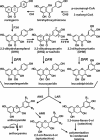



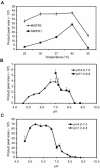
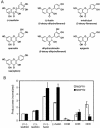
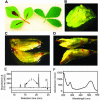
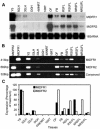
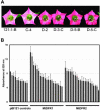

Similar articles
-
Molecular cloning and characterization of three genes encoding dihydroflavonol-4-reductase from Ginkgo biloba in anthocyanin biosynthetic pathway.PLoS One. 2013 Aug 26;8(8):e72017. doi: 10.1371/journal.pone.0072017. eCollection 2013. PLoS One. 2013. PMID: 23991027 Free PMC article.
-
Early steps in proanthocyanidin biosynthesis in the model legume Medicago truncatula.Plant Physiol. 2007 Nov;145(3):601-15. doi: 10.1104/pp.107.107326. Epub 2007 Sep 20. Plant Physiol. 2007. PMID: 17885080 Free PMC article.
-
Gene characterization, analysis of expression and in vitro synthesis of dihydroflavonol 4-reductase from [Citrus sinensis (L.) Osbeck].Phytochemistry. 2006 Apr;67(7):684-95. doi: 10.1016/j.phytochem.2006.01.025. Epub 2006 Mar 9. Phytochemistry. 2006. PMID: 16524606
-
Gene duplication and mobile genetic elements in the morning glories.Gene. 2001 Mar 7;265(1-2):1-10. doi: 10.1016/s0378-1119(01)00357-2. Gene. 2001. PMID: 11255002 Review.
-
Birdsfoot trefoil: a model for studying the synthesis of condensed tannins.Basic Life Sci. 1999;66:343-56. doi: 10.1007/978-1-4615-4139-4_18. Basic Life Sci. 1999. PMID: 10800452 Review. No abstract available.
Cited by
-
Insights of Phenolic Pathway in Fruits: Transcriptional and Metabolic Profiling in Apricot (Prunus armeniaca).Int J Mol Sci. 2021 Mar 26;22(7):3411. doi: 10.3390/ijms22073411. Int J Mol Sci. 2021. PMID: 33810284 Free PMC article.
-
Integrated analysis of metabolome and transcriptome reveals key candidate genes involved in flavonoid biosynthesis in Pinellia ternata under heat stress.J Plant Res. 2023 May;136(3):359-369. doi: 10.1007/s10265-023-01446-8. Epub 2023 Mar 7. J Plant Res. 2023. PMID: 36881276 Free PMC article.
-
Engineering de novo anthocyanin production in Saccharomyces cerevisiae.Microb Cell Fact. 2018 Jul 3;17(1):103. doi: 10.1186/s12934-018-0951-6. Microb Cell Fact. 2018. PMID: 29970082 Free PMC article.
-
Relationship between gene expression and the accumulation of catechin during spring and autumn in tea plants (Camellia sinensis L.).Hortic Res. 2015 Apr 1;2:15011. doi: 10.1038/hortres.2015.11. eCollection 2015. Hortic Res. 2015. PMID: 26504566 Free PMC article.
-
In silico study for diversing the molecular pathway of pigment formation: an alternative to manual coloring in cotton fibers.Front Plant Sci. 2015 Sep 17;6:751. doi: 10.3389/fpls.2015.00751. eCollection 2015. Front Plant Sci. 2015. PMID: 26442064 Free PMC article.
References
-
- Almeida J, Carpenter R, Robbins TP, Martin C, Coen ES (1989) Genetic interactions underlying flower color patterns in Antirrhinun majus. Genes Dev 3: 1758-1767 - PubMed
-
- Baggett BR, Cooper JD, Hogan ET, Carper J, Paiva NL, Smith JT (2002) Profiling isoflavonoids found in legume root extracts using capillary electrophoresis. Electrophoresis 23: 1642-1651 - PubMed
-
- Beld M, Martin C, Huits H, Stuitje AR, Gerats AG (1989) Flavonoid synthesis in Petunia hybrida: partial characterization of dihydroflavonol-4-reductase genes. Plant Mol Biol 13: 491-502 - PubMed
-
- Bongue-Bartelsman M, O'Neill SD, Tong Y, Yoder JI (1994) Characterization of the gene encoding dihydroflavonol 4-reductase in tomato. Gene 138: 153-157 - PubMed
Publication types
MeSH terms
Substances
LinkOut - more resources
Full Text Sources
Other Literature Sources

